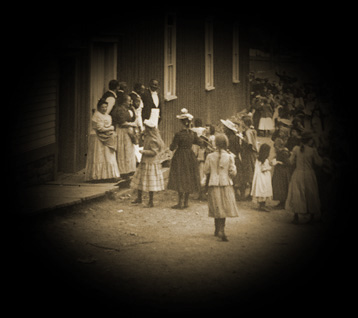

Back to exhibits
 |  Back to exhibits |
Immigrants in the coal region
 |
Most of the Welsh and English emigrants to Saint Clair came from the richest coal districts of the British Isles, and many had already obtained valuable skills working in and around the mines. Drawing upon these experiences, Welshmen and Englishmen were able to move into the most highly-paid, highly-skilled work in the mines and to maneuver rapidly into supervisory positions. The fates of Irish immigrants, on the other hand, were more varied, depending largely on the timing and circumstances of their arrival and their background in Ireland.
Of the thousands who fled Ireland during the great famine of 1845-1849, most were financially and physically devastated, and coming from backgrounds as laborers or farmers, were ill equipped for work in the mines. Hailing largely from Counties Donegal and Mayo, the famine-era Irish were more likely to live in the patches than towns, and more likely to work as laborers than skilled miners.
 |
As a result, many Kilkennians arrived in Saint Clair in better financial and physical condition than their compatriots and were able to build on previous experience to improve their lots. Like their Welsh and English counterparts, many Kilkennians were able to obtain work in the most highly-paid skilled and supervisory positions. This parity with the English and Welsh extended to socializing outside of work: "Kilkenny miners" associated less frequently with other Irish emigrants and more with Welsh, English, and Germans. More tellingly, during the ethnic conflicts of the Molly Maguire era, Kilkenny men joined with Welshmen in the "Chain Gang," known for its violent conflicts with Irish from western Irish counties such as Donegal, Mayo, and Galway.
 |
Workingmen's Benevolent Association |
The majority of German immigrants had roots in village life with its distinctions of social rank, and most tended to settle in town. There Germans entered into familiar lines of work, becoming artisans, craftsmen, and shopkeepers.
The experiences of women in the coal region - women of any ethnic background - diverged sharply from that of the men. Prior to the establishment of silk mills in the early 1900s, women found few legitimate employment opportunities in the coal region. While Irish women who settled in the major cities might find work as domestics or in mills, thus enabling single women to fend for themselves, in the coal regions women tended to emigrate with husbands or families and most listed their occupations as "keeping house." Although most native-born American women were less well educated than their male counterparts during the nineteenth century, women in the coal regions were often better educated than their husbands, fathers, and brothers. The greater (external) work opportunities for males led them to drop out of school at younger ages than their female siblings. One often finds examples in the census of wives who could read and write while their husbands could not -- the reverse of the pattern commonly seen in urban areas and rural farming areas.